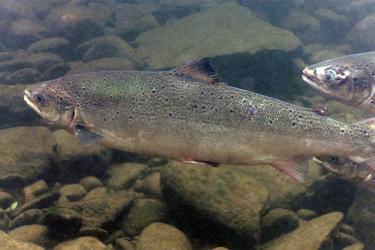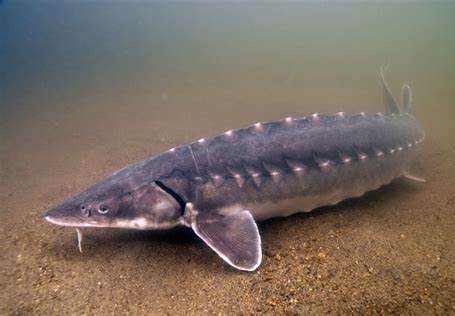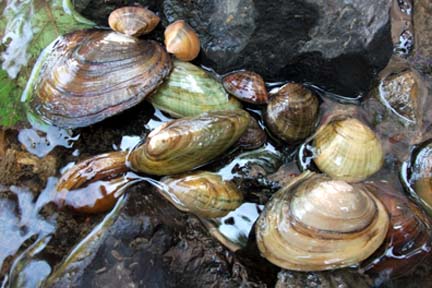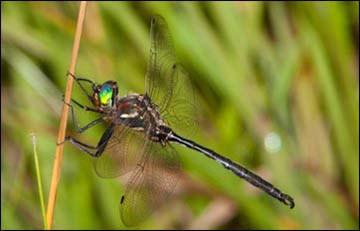
Request for Information
In October 2021, FEMA published a Request for Information (RFI) notice in the Federal Register seeking public comment on the National Flood Insurance Program’s minimum floodplain standards, and on ways to better promote conservation of threatened and endangered species, and their habitats, consistent with the Endangered Species Act.
FEMA is now in the process of reviewing the 431 comments received in response to the RFI as part of the agency’s broader effort to improve the NFIP and protect listed species.
This page discusses the benefits of conserving endangered species.
Scientists estimate that between 10 and 50 million species inhabit our planet worldwide, although only approximately 1.7 million organisms have been catalogued (Why Save Endangered Species? USFWS, July 2005). All living things are part of a complex, often delicately balanced network called the biosphere, which is comprised of ecosystems. The removal of a single species can set off a chain reaction that can have devastating effects on the system as a whole.
There are specific benefits of conserving species and maintaining species diversity, which can be thought of as “values.” These values include three types of benefits: consumptive (e.g., harvesting, fishing, medicine), non-consumptive (e.g., wildlife viewing, ecosystem balance, ecotourism, cultural heritage), and non-use (e.g., species existence). For a more detailed account of the values associated with protecting wildlife and threatened and endangered species including medicinal, agricultural, and natural diversity values, please read the U.S. Fish and Wildlife Service publication, Why Save Endangered Species?.
As stated in the Endangered Species Act (ESA), Congress recognizes the “aesthetic, ecological, educational, historical, recreational, and scientific value” of conserving endangered and threatened species. In passing the ESA in 1973, Congress codified the Government’s commitment to promoting the recovery of threatened and endangered species and the conservation of the critical habitat on which they depend. A species is considered endangered if it is in danger of extinction throughout all or a significant portion of its range, and a species is considered threatened if it is likely to become endangered in the future (Endangered Species Act, 1973). There are approximately 1,775 species listed as threatened or endangered under the ESA.
The National Marine Fisheries Service (NMFS) and the U.S. Fish and Wildlife Service (USFWS) administer the ESA for all threatened and endangered species. NMFS generally has jurisdiction over marine species, and USFWS has jurisdiction over all other listed species. A primary goal for both USFWS and NMFS is to support species recovery. Collectively, these federal agencies are responsible for identification and listing of species as threatened or endangered; the designation of critical habitat, development of species-specific recovery plans; cooperation with state, tribal, and local governments; and consultation with other federal agencies to ensure federal activities do not jeopardize the continued existence of a species.

What is critical habitat? Critical habitat refers to the specific geographic areas that contain physical and biological features essential to the conservation of an endangered or threatened species and that may require special management and protection (Endangered Species Act, 1973). Critical habitat may also include areas that are not currently occupied by the species but will be needed for its recovery.
Endangered Species in the Floodplain
What kind of threatened and endangered species live in or near the floodplain?
Floodplains and their adjacent habitats are essential for the survival of many threatened and endangered species, ranging from sturgeon to dragonflies. The text and links below explore the stories of just a few of these species and their ties to the floodplain.
Atlantic Salmon (Salmo salar), Gulf of Maine Population

The Atlantic Salmon Gulf of Maine Distinct Population Segment (DPS), which falls under joint jurisdiction of NMFS and USFWS, was originally ESA-listed as endangered in 2000. The Gulf of Maine DPS is one of eight NMFS “Species in the Spotlight,” which is comprised of species listed under the ESA for which immediate, targeted efforts are vital for stabilizing their populations and preventing their extinction.
Critical habitat for Atlantic Salmon is characterized by deep, oxygenated pools and cover (e.g., boulders, woody debris, vegetation, etc.) near freshwater spawning sites that provide adults protection from predators and other environmental variables such as high flows, high temperatures, and sedimentation. The species is affected by development and other land-use decisions within the floodplain, and recovery actions include providing long-term protection for riparian buffers through fee acquisition, conservation easements, and conservation and management agreements, among others.
For more information, see the NMFS Atlantic Salmon page and Species in the Spotlight 5-Year Action Plan: Atlantic Salmon.
Gulf Sturgeon (Acipenser oxyrinchus desotoi)
USFWS and NMFS have shared jurisdiction over the Gulf Sturgeon, which was listed as threatened in 1991.
Critical habitat features for the species include a flow regime, water quality (including temperature, salinity, and pH), and sediment quality necessary for normal behavior, growth, and survival of all life stages in the riverine environment.

Gulf sturgeon are anadromous, with adults spawning in freshwater and migrating into marine waters in the fall to forage and overwinter. Critical habitat features for the species include a flow regime, water quality (including temperature, salinity, and pH), and sediment quality necessary for normal behavior, growth, and survival of all life stages in the riverine environment
The species is affected by development and other land-use decisions within the floodplain that impact water quantity and quality, and recovery actions include identifying and protecting and/or acquiring appropriate habitat based on an ecosystem approach (i.e., protecting all habitats that impact the lifecycle of the Gulf Sturgeon, including floodplains adjacent to the streams and rivers where they spawn).
For more information, see the NMFS Gulf Sturgeon page, and USFWS Gulf Sturgeon Fact Sheet.
Freshwater Mussels (numerous species)

The U.S. is home to over 300 species of mussel, the greatest diversity of freshwater mussels in the world. Approximately 32%, or 95 species of mussel, are protected as endangered or threatened under the ESA.
Mussels are an important component of the aquatic ecosystem. As they filter water to obtain food, mussels also remove impurities and clean the water.
In addition, they are a food source for many other species of wildlife, and groups of mussels clustered on the water bottom create habitat for fish, aquatic insects, and worms. Almost all mussel species are threatened by habitat destruction and degraded water quality, which can occur from disturbances in the floodplain, including development.
For more information, see the Freshwater Mollusk Conservation Society (FMCS) webpage and the USFWS webpages on mussels in the Midwest. Note: additional websites exist for the numerous mussel species under USFWS jurisdiction.
Hine’s emerald dragonfly (Somatochlora hineana)
The Hine’s emerald dragonfly was federally listed as endangered in 1995. It currently exists only in small areas of four Midwestern states.
Adults lay their eggs in small streams in fens and sedge meadows. After hatching, the aquatic larvae spend up to five years in wetlands before completely maturing and emerging as adult dragonflies.

The habitat for all identified populations is associated with areas of groundwater-fed wetlands that are perched over limestone bedrock. The greatest threat to the Hine's emerald dragonfly is habitat destruction. Most of the wetland habitat this dragonfly depends on for survival has been drained and filled for urban and industrial development.
For more information, see the USFWS Hine’s emerald dragonfly webpage.
Find Threatened and Endangered Species and Critical Habitat in Your Community
Tools exist to help communities identify threatened and endangered species and critical habitat within their jurisdictions. Understanding if your community is home to listed species or their critical habitat is the first step to taking action to conserve species and the habitat on which they depend.
- USFWS’s Information for Planning and Consultation tool (IPaC). If you are considering a project that may affect a species proposed or listed under the ESA or any other USFWS trust resources such as migratory birds, inter-jurisdiction fish, specific marine mammals, and National Wildlife Refuges, IPaC can provide you with a list of species and critical habitat within a project area. IPaC may also be able to provide information on likely impacts to species from particular projects and a list of suggested actions for addressing them. By obtaining this information early in the project development process, project proponents can more easily incorporate it into their planning, thus saving time and money and avoiding potential project delays. IPaC also provides contact information for the local USFWS office in your area.
- Several NMFS regional offices provide public tools to help communities determine whether threatened and endangered species reside or critical habitat exists within their jurisdictions, including the West Coast ESA Protected Resources Tool, the Southeast Regional Office's digital maps and GIS data, the Alaska Regional Office's Endangered Species Interactive Map, and the Greater Atlantic Region's ESA Mapper.
- FEMA developed FRESH, an ESA/NFIP mapping GeoPlatform tool, to help NFIP communities determine where species and critical habitat are located in relation to special flood hazard areas and other floodplains within NFIP communities.
Actions to Conserve Species and Protect Habitat
Community Rating System (CRS) and Species Conservation
In the 2021 Addendum to the CRS Coordinators’ Manual, FEMA added two new credits that encourage communities to learn more about the threatened and endangered species with range or critical habitat in the community and to identify ways the community can help those species recover: credit for developing a Floodplain Species Assessment (FSA) and Floodplain Species Plan (FSP). The “Preparing A Floodplain Species Assessment and A Floodplain Species Plan for Credit under the Community Rating System” guidance provides a step-by-step approach to identifying locally relevant threatened and endangered species and developing a plan to help them.
FEMA encourages communities and project proponents to reach out to experts in wildlife and species conservation to discuss developing strategies to enhance existing habitat and reduce threats to specific species in their area. The following links can help get your community started on identifying key points of contact and incorporating habitat protection into floodplain management and land-use decisions.
- The USFWS Coastal Program plays an important role in promoting the Service’s mission and priorities, delivering landscape-scale conservation and implementing strategic habitat conservation. The program is located in 24 priority coastal areas along the Atlantic and Pacific Oceans, Gulf of Mexico, Great Lakes, and in the Caribbean. Working with partners, locally-based staff provide technical assistance for habitat conservation design and planning, and financial assistance for habitat restoration and protection projects. In addition, the Partners for Fish and Wildlife Program works with private landowners to improve fish and wildlife habitat on their lands by providing funding and technical assistance in any landscape.
- National Marine Fisheries Species Recovery Grants to States (formerly called "Protected Species Cooperative Conservation Grants") support management, research, monitoring, and/or outreach activities that conserve listed species, recently de-listed species, and proposed and candidate species.
- Floodplain Buyouts: An Action Guide for Local Governments on How to Maximize Community Benefits, Habitat Connectivity, and Resilience (Environmental Law Institute and the University of North Carolina-Chapel Hill Institute for the Environment) provides practical, implementable recommendations for local governments on how to leverage hazard mitigation voluntary property acquisitions supported by federal programs to protect, restore, and connect habitats. Once purchased, communities can make land use decisions that restore and permanently protect these properties to provide natural habitats and help conserve biodiversity while also providing community amenities and improving resilience.
Recovery Partnership Success Stories
Modesto, California: Partially funded by the USFWS Partners for Fish and Wildlife Program, the Tuolumne River Trust worked for 10 years to acquire the Dos Rios Ranch property in Modesto, California. The property consists of over 1,600 acres at the confluence of the Tuolumne and San Joaquin rivers and contains remnant floodplain habitats that include wetlands, riparian woodlands, and agricultural lands. Since the acquisition, restoration efforts have taken place to restore habitats for the threatened and endangered species in the area, as well as improve floodplain management and provide recreational opportunities.
Lake County, Illinois: Supported by funding from the USFWS Great Lakes Coastal Program, the Lake County, Illinois Forest Preserve District implemented a large-scale project to enhance coastal habitats at the Spring Bluff Preserve along the coast of Lake Michigan. The project led to the enhancement of 135 acres of coastal wetland as well as 40 acres of sand savanna habitat, which are important breeding and foraging grounds for rare wildlife species in Illinois.

